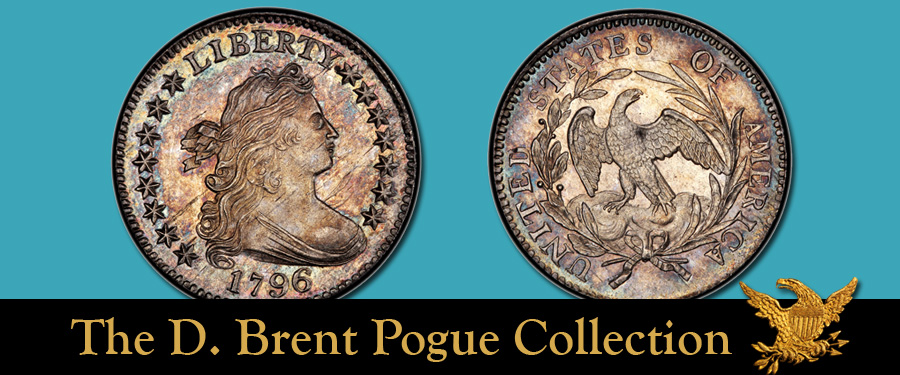
Among the highlights of the D. Brent Pogue Collection Part 1 scheduled to cross the block on May 19 is a Superb Gem 1796 dime graded MS-66+ by PCGS. There are six known die varieties of this year, of which this JR-4 variety is one of the scarcest.
Although this denomination was authorized by the Mint Act of April 2, 1792, it was not until 1796 that dimes were first struck at the Philadelphia Mint. In that year the coinage amounted to 22,135 pieces. The design features the Draped Bust representation of Liberty, thought by some to have been from a sketch by Gilbert Stuart of a Philadelphia society lady, although facts are scarce. This motif was created in the autumn of 1795 when it was used to create two dies for silver dollars. A Draped Bust 1795 half dime die was also made, but not used at the time. In 1796 it was overdated with a 6 digit, creating the 1796/5, the subject of our Internet commentary two weeks ago.
The reverse is of the Small Eagle type created in autumn 1795 and used on silver dollars. An eagle perched on a large puffy cloud is within a wreath that is open at the top.
In 1796, quarter dollars were also made for the first time, employing the same designs as the dime.
For all 1796 dimes—considering the six combinations—Mint State examples appear on the market from time to time. Although no record has been found of any being saved for presentation or museum purposes, likely some were set aside as souvenirs. Accordingly, 1796 dimes in Choice or Gem Mint State as a whole are not landmark rarities. However, 1796 dimes of the JR-4 variety certainly are! Not only is the Pogue Collection specimen the finest graded, it is well struck and is gorgeous to behold.
It has been estimated that about 2,750 dimes were coined from this die pair, and that only about 200 survive today, all in grades below the Pogue gem, usually far below.
Prior to its acquisition by Brent Pogue this memorable gem was owned by three other numismatists who in sequence formed some of the greatest type sets ever assembled: Hank Rogers, Jimmy Hayes, and Claude Davis, M.D., the holdings of the last being named the Foxfire Collection. To each this 1796 gem was a treasure, as it will be to its next fortunate owner.





